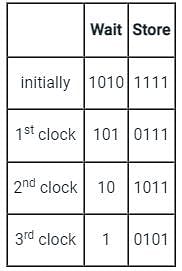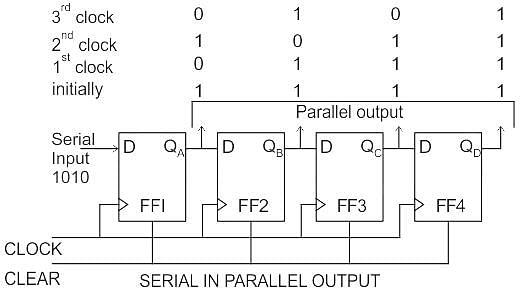Electrical Engineering (EE) Exam > Electrical Engineering (EE) Questions > A 4 bit serial in parallel out shift register...
Start Learning for Free
A 4 bit serial in parallel out shift register is initially set to 1111. The data 1010 is applied to the input. After 3 clock cycles the output will be:
- a)1100
- b)0101
- c)1011
- d)1010
Correct answer is option 'B'. Can you explain this answer?
Most Upvoted Answer
A 4 bit serial in parallel out shift register is initially set to 1111...
Given information:
- 4-bit serial in parallel out shift register
- Initial state of register = 1111
- Input data = 1010
- 3 clock cycles passed
To find:
- Output of shift register after 3 clock cycles
Solution:
The given shift register is a serial in parallel out register, which means that data is entered into the register bit by bit serially, but the output is taken in parallel form.
The initial state of the register is 1111, which means that all the four bits are in the high state.
The input data is 1010, which means that the first bit is 1, second bit is 0, third bit is 1 and fourth bit is 0.
The data is entered into the shift register serially, starting from the leftmost bit. So, the first clock cycle will shift the initial state of the register to the left by one bit and the first bit of the input data will be entered into the rightmost bit of the register.
After the first clock cycle, the register will have the following state:
- 1111 (initial state) -> 1110 (after 1 clock cycle)
In the second clock cycle, the same process will be repeated and the second bit of the input data will be entered into the rightmost bit of the register.
After the second clock cycle, the register will have the following state:
- 1110 (state after 1 clock cycle) -> 1101 (after 2 clock cycles)
In the third clock cycle, the same process will be repeated and the third bit of the input data will be entered into the rightmost bit of the register.
After the third clock cycle, the register will have the following state:
- 1101 (state after 2 clock cycles) -> 1010 (after 3 clock cycles)
So, the output of the shift register after 3 clock cycles will be 1010, which is the same as the input data.
Therefore, the correct answer is option B (0101).
- 4-bit serial in parallel out shift register
- Initial state of register = 1111
- Input data = 1010
- 3 clock cycles passed
To find:
- Output of shift register after 3 clock cycles
Solution:
The given shift register is a serial in parallel out register, which means that data is entered into the register bit by bit serially, but the output is taken in parallel form.
The initial state of the register is 1111, which means that all the four bits are in the high state.
The input data is 1010, which means that the first bit is 1, second bit is 0, third bit is 1 and fourth bit is 0.
The data is entered into the shift register serially, starting from the leftmost bit. So, the first clock cycle will shift the initial state of the register to the left by one bit and the first bit of the input data will be entered into the rightmost bit of the register.
After the first clock cycle, the register will have the following state:
- 1111 (initial state) -> 1110 (after 1 clock cycle)
In the second clock cycle, the same process will be repeated and the second bit of the input data will be entered into the rightmost bit of the register.
After the second clock cycle, the register will have the following state:
- 1110 (state after 1 clock cycle) -> 1101 (after 2 clock cycles)
In the third clock cycle, the same process will be repeated and the third bit of the input data will be entered into the rightmost bit of the register.
After the third clock cycle, the register will have the following state:
- 1101 (state after 2 clock cycles) -> 1010 (after 3 clock cycles)
So, the output of the shift register after 3 clock cycles will be 1010, which is the same as the input data.
Therefore, the correct answer is option B (0101).
Free Test
FREE
| Start Free Test |
Community Answer
A 4 bit serial in parallel out shift register is initially set to 1111...
Concept: In serial IN/Parallel out shift register data will be shifted all at a time with every clock pulse.
since initially 1111 stored

so after 3rd clock pulse output will be 0101


|
Explore Courses for Electrical Engineering (EE) exam
|

|
Similar Electrical Engineering (EE) Doubts
A 4 bit serial in parallel out shift register is initially set to 1111. The data 1010 is applied to the input. After 3 clock cycles the output will be:a)1100b)0101c)1011d)1010Correct answer is option 'B'. Can you explain this answer?
Question Description
A 4 bit serial in parallel out shift register is initially set to 1111. The data 1010 is applied to the input. After 3 clock cycles the output will be:a)1100b)0101c)1011d)1010Correct answer is option 'B'. Can you explain this answer? for Electrical Engineering (EE) 2025 is part of Electrical Engineering (EE) preparation. The Question and answers have been prepared according to the Electrical Engineering (EE) exam syllabus. Information about A 4 bit serial in parallel out shift register is initially set to 1111. The data 1010 is applied to the input. After 3 clock cycles the output will be:a)1100b)0101c)1011d)1010Correct answer is option 'B'. Can you explain this answer? covers all topics & solutions for Electrical Engineering (EE) 2025 Exam. Find important definitions, questions, meanings, examples, exercises and tests below for A 4 bit serial in parallel out shift register is initially set to 1111. The data 1010 is applied to the input. After 3 clock cycles the output will be:a)1100b)0101c)1011d)1010Correct answer is option 'B'. Can you explain this answer?.
A 4 bit serial in parallel out shift register is initially set to 1111. The data 1010 is applied to the input. After 3 clock cycles the output will be:a)1100b)0101c)1011d)1010Correct answer is option 'B'. Can you explain this answer? for Electrical Engineering (EE) 2025 is part of Electrical Engineering (EE) preparation. The Question and answers have been prepared according to the Electrical Engineering (EE) exam syllabus. Information about A 4 bit serial in parallel out shift register is initially set to 1111. The data 1010 is applied to the input. After 3 clock cycles the output will be:a)1100b)0101c)1011d)1010Correct answer is option 'B'. Can you explain this answer? covers all topics & solutions for Electrical Engineering (EE) 2025 Exam. Find important definitions, questions, meanings, examples, exercises and tests below for A 4 bit serial in parallel out shift register is initially set to 1111. The data 1010 is applied to the input. After 3 clock cycles the output will be:a)1100b)0101c)1011d)1010Correct answer is option 'B'. Can you explain this answer?.
Solutions for A 4 bit serial in parallel out shift register is initially set to 1111. The data 1010 is applied to the input. After 3 clock cycles the output will be:a)1100b)0101c)1011d)1010Correct answer is option 'B'. Can you explain this answer? in English & in Hindi are available as part of our courses for Electrical Engineering (EE).
Download more important topics, notes, lectures and mock test series for Electrical Engineering (EE) Exam by signing up for free.
Here you can find the meaning of A 4 bit serial in parallel out shift register is initially set to 1111. The data 1010 is applied to the input. After 3 clock cycles the output will be:a)1100b)0101c)1011d)1010Correct answer is option 'B'. Can you explain this answer? defined & explained in the simplest way possible. Besides giving the explanation of
A 4 bit serial in parallel out shift register is initially set to 1111. The data 1010 is applied to the input. After 3 clock cycles the output will be:a)1100b)0101c)1011d)1010Correct answer is option 'B'. Can you explain this answer?, a detailed solution for A 4 bit serial in parallel out shift register is initially set to 1111. The data 1010 is applied to the input. After 3 clock cycles the output will be:a)1100b)0101c)1011d)1010Correct answer is option 'B'. Can you explain this answer? has been provided alongside types of A 4 bit serial in parallel out shift register is initially set to 1111. The data 1010 is applied to the input. After 3 clock cycles the output will be:a)1100b)0101c)1011d)1010Correct answer is option 'B'. Can you explain this answer? theory, EduRev gives you an
ample number of questions to practice A 4 bit serial in parallel out shift register is initially set to 1111. The data 1010 is applied to the input. After 3 clock cycles the output will be:a)1100b)0101c)1011d)1010Correct answer is option 'B'. Can you explain this answer? tests, examples and also practice Electrical Engineering (EE) tests.

|
Explore Courses for Electrical Engineering (EE) exam
|

|
Signup for Free!
Signup to see your scores go up within 7 days! Learn & Practice with 1000+ FREE Notes, Videos & Tests.
























